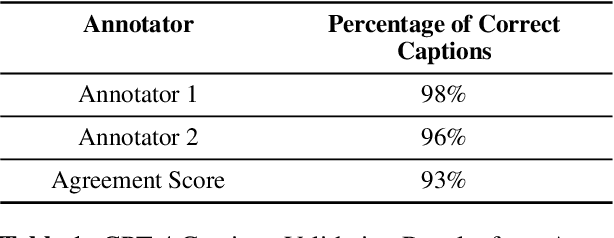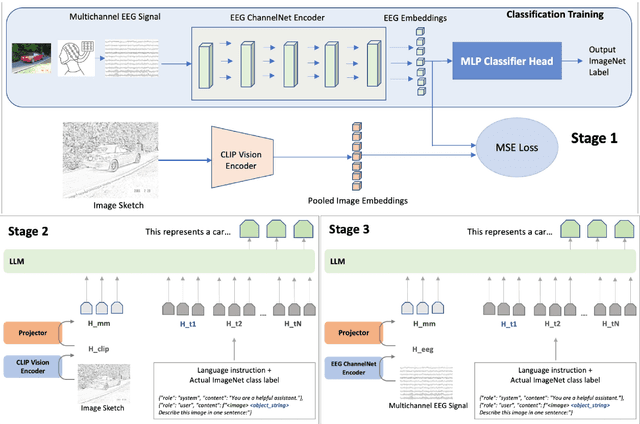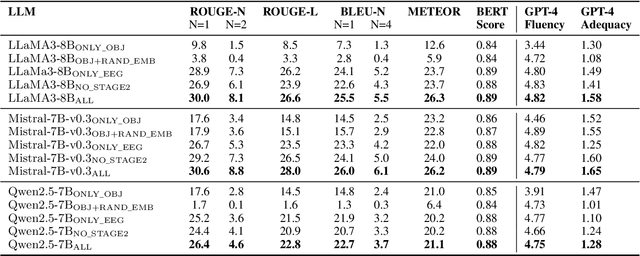Shreya Shukla
A Survey on Bridging EEG Signals and Generative AI: From Image and Text to Beyond
Feb 18, 2025Abstract:Integration of Brain-Computer Interfaces (BCIs) and Generative Artificial Intelligence (GenAI) has opened new frontiers in brain signal decoding, enabling assistive communication, neural representation learning, and multimodal integration. BCIs, particularly those leveraging Electroencephalography (EEG), provide a non-invasive means of translating neural activity into meaningful outputs. Recent advances in deep learning, including Generative Adversarial Networks (GANs) and Transformer-based Large Language Models (LLMs), have significantly improved EEG-based generation of images, text, and speech. This paper provides a literature review of the state-of-the-art in EEG-based multimodal generation, focusing on (i) EEG-to-image generation through GANs, Variational Autoencoders (VAEs), and Diffusion Models, and (ii) EEG-to-text generation leveraging Transformer based language models and contrastive learning methods. Additionally, we discuss the emerging domain of EEG-to-speech synthesis, an evolving multimodal frontier. We highlight key datasets, use cases, challenges, and EEG feature encoding methods that underpin generative approaches. By providing a structured overview of EEG-based generative AI, this survey aims to equip researchers and practitioners with insights to advance neural decoding, enhance assistive technologies, and expand the frontiers of brain-computer interaction.
Towards Making Flowchart Images Machine Interpretable
Jan 29, 2025Abstract:Computer programming textbooks and software documentations often contain flowcharts to illustrate the flow of an algorithm or procedure. Modern OCR engines often tag these flowcharts as graphics and ignore them in further processing. In this paper, we work towards making flowchart images machine-interpretable by converting them to executable Python codes. To this end, inspired by the recent success in natural language to code generation literature, we present a novel transformer-based framework, namely FloCo-T5. Our model is well-suited for this task,as it can effectively learn semantics, structure, and patterns of programming languages, which it leverages to generate syntactically correct code. We also used a task-specific pre-training objective to pre-train FloCo-T5 using a large number of logic-preserving augmented code samples. Further, to perform a rigorous study of this problem, we introduce theFloCo dataset that contains 11,884 flowchart images and their corresponding Python codes. Our experiments show promising results, and FloCo-T5 clearly outperforms related competitive baselines on code generation metrics. We make our dataset and implementation publicly available.
PatentLMM: Large Multimodal Model for Generating Descriptions for Patent Figures
Jan 25, 2025Abstract:Writing comprehensive and accurate descriptions of technical drawings in patent documents is crucial to effective knowledge sharing and enabling the replication and protection of intellectual property. However, automation of this task has been largely overlooked by the research community. To this end, we introduce PatentDesc-355K, a novel large-scale dataset containing ~355K patent figures along with their brief and detailed textual descriptions extracted from more than 60K US patent documents. In addition, we propose PatentLMM - a novel multimodal large language model specifically tailored to generate high-quality descriptions of patent figures. Our proposed PatentLMM comprises two key components: (i) PatentMME, a specialized multimodal vision encoder that captures the unique structural elements of patent figures, and (ii) PatentLLaMA, a domain-adapted version of LLaMA fine-tuned on a large collection of patents. Extensive experiments demonstrate that training a vision encoder specifically designed for patent figures significantly boosts the performance, generating coherent descriptions compared to fine-tuning similar-sized off-the-shelf multimodal models. PatentDesc-355K and PatentLMM pave the way for automating the understanding of patent figures, enabling efficient knowledge sharing and faster drafting of patent documents. We make the code and data publicly available.
Thought2Text: Text Generation from EEG Signal using Large Language Models (LLMs)
Oct 10, 2024



Abstract:Decoding and expressing brain activity in a comprehensible form is a challenging frontier in AI. This paper presents Thought2Text, which uses instruction-tuned Large Language Models (LLMs) fine-tuned with EEG data to achieve this goal. The approach involves three stages: (1) training an EEG encoder for visual feature extraction, (2) fine-tuning LLMs on image and text data, enabling multimodal description generation, and (3) further fine-tuning on EEG embeddings to generate text directly from EEG during inference. Experiments on a public EEG dataset collected for six subjects with image stimuli demonstrate the efficacy of multimodal LLMs (LLaMa-v3, Mistral-v0.3, Qwen2.5), validated using traditional language generation evaluation metrics, GPT-4 based assessments, and evaluations by human expert. This approach marks a significant advancement towards portable, low-cost "thoughts-to-text" technology with potential applications in both neuroscience and natural language processing (NLP).
 Add to Chrome
Add to Chrome Add to Firefox
Add to Firefox Add to Edge
Add to Edge